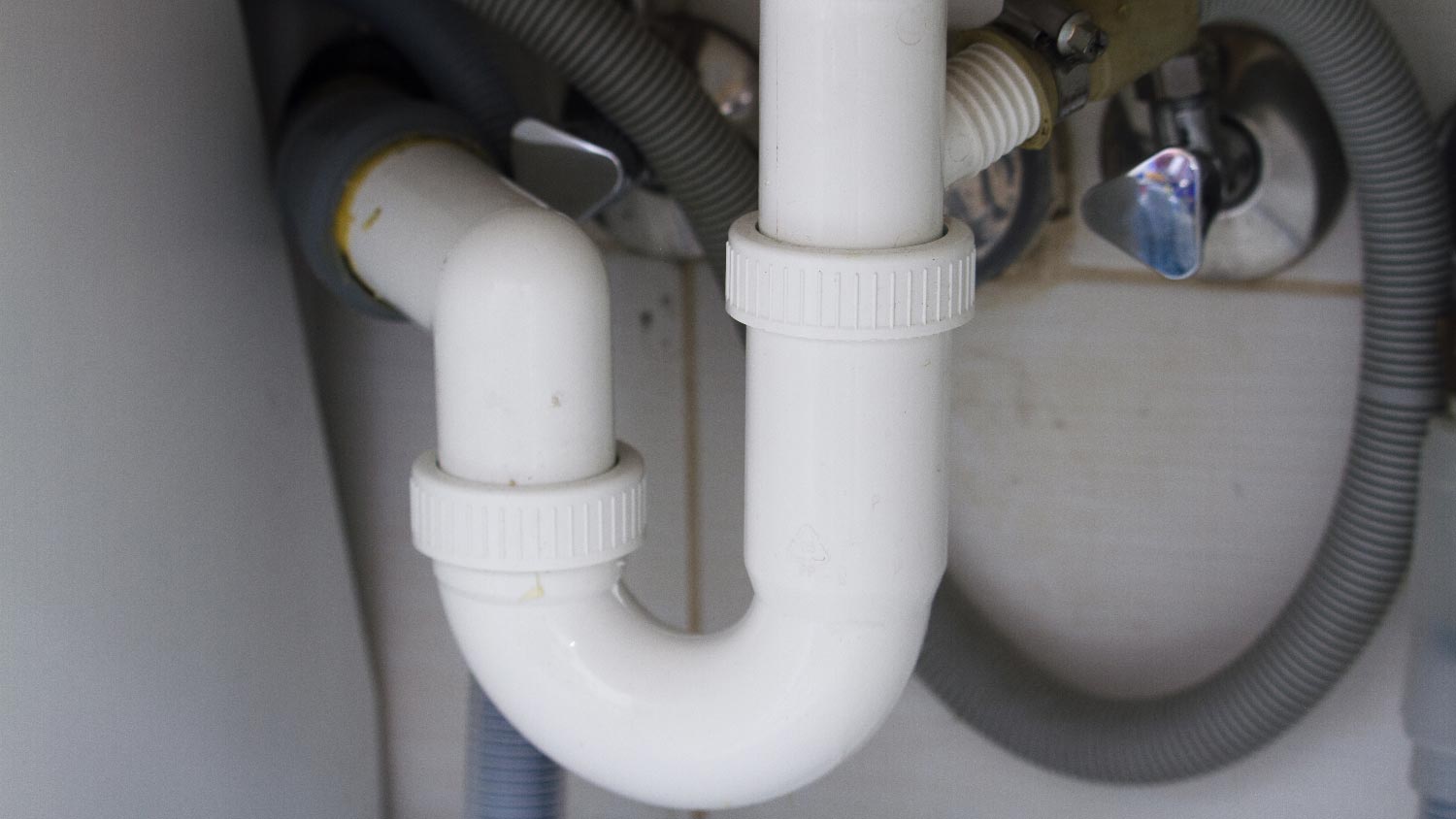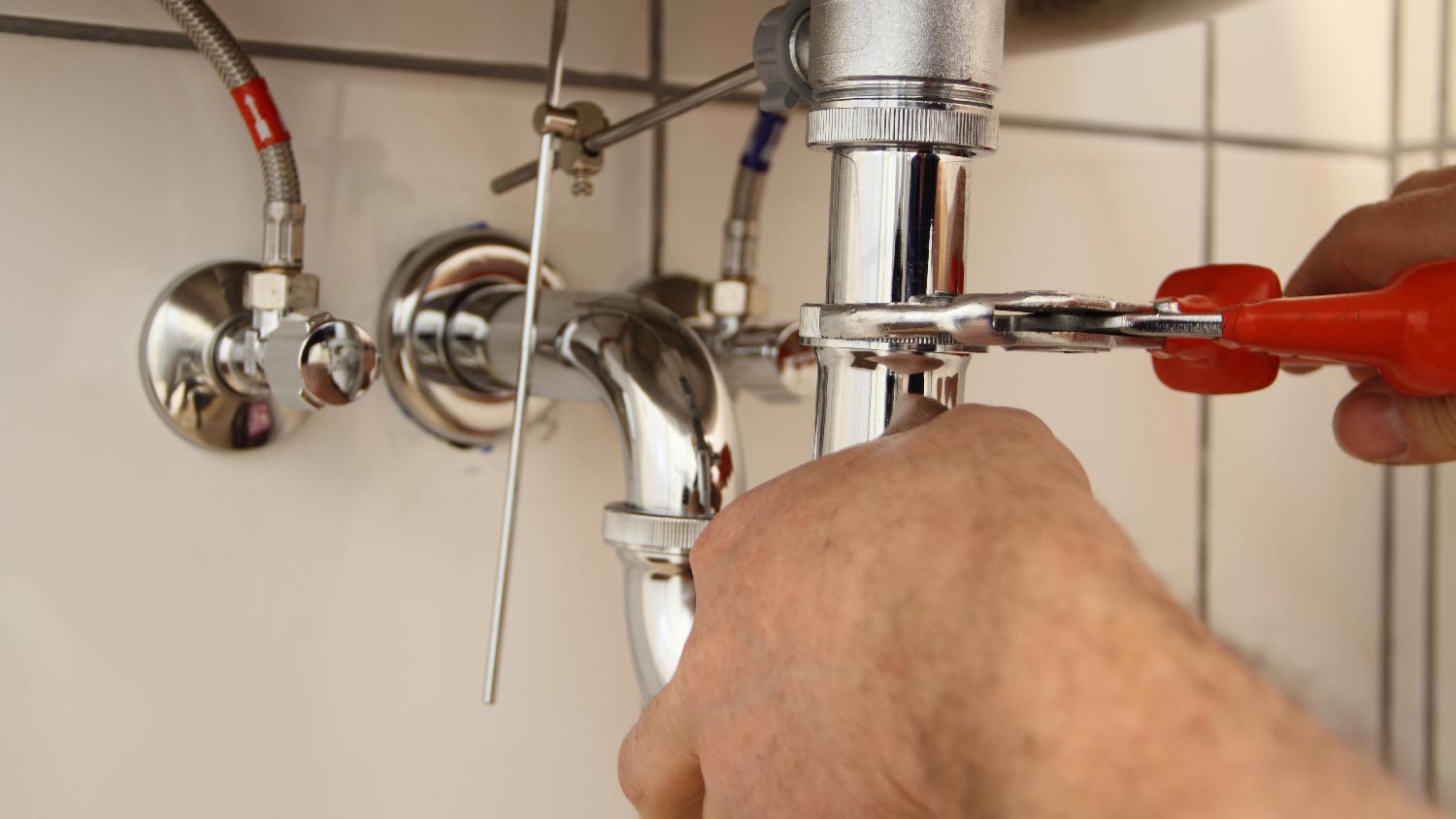What Size P-Trap Should I Use for a Bathroom Sink?
The right size P-trap will stop major clogs and banish sewer odors from your home


Bathroom sinks use a standard 1 ¼-inch P-trap.
You can find traps as large as 2 inches, especially in showers and toilets.
Incorrect sizing can cause clogs and let sewer gases into your home.
Your local plumbing code dictates P-trap sizing.
A standard under-sink PVC P-trap costs between $5 and $50.
P-traps may not be exciting, but they’re why your drainage system works. This curved section of piping prevents nasty sewer odors from seeping into your home and helps combat clogs by catching debris before it travels further into your plumbing. P-traps come in various sizes, but most residential bathrooms use a standard size. This guide dives into everything you need to know about which P-trap size you need for a bathroom sink.
What Is the Standard Size for a Bathroom Sink P-Trap?
P-traps come in two standard sizes: 1 ¼ inches for bathroom sinks or 1 ½ inches for kitchen sinks. Larger sizes—up to 2 inches in diameter—are reserved for showers and toilets. In some rare instances, you may have a larger bathroom sink P-trap size, but it’s not the norm.
Your bathroom sink uses a trap made from PVC or metal. Size matters because you want your pipes to fit correctly, but you should also choose a P-trap made from the same material as the rest of your sink plumbing.
P-Trap Size by Type

Like other types of pipe fittings, P-trap sizing is standard. Nonetheless, there are some instances where your bathroom may call for a slightly larger trap. It depends on whether your sink has a higher drainage volume than most residential bathrooms. Here are some common sizes that you’ll find throughout your home.
| Type of P-Trap | Sink or Fixture | Size (Inches) |
|---|---|---|
| Small | Bathroom sinks | 1 ¼ |
| Medium | Kitchen sinks, utility room sinks, and commercial installations | 1 ½ |
| Large | Specialized sinks with a large flow capacity, showers, and toilets | 2 |
Small
The smallest P-trap in your bathroom is beneath your sink. Most residential bathroom sinks use a standard 1 ¼-inch P-trap, made to fit with a 1 ¼-inch drainpipe as required by local plumbing codes. A local plumbing professional can advise on which size is best for your setup and will be familiar with the code in your area.
Medium
There are times when a bathroom sink uses a P-trap that’s 1 ½ inches in diameter. This slightly larger size can accommodate the volume of a commercial or large-scale installation. You may find this size in your bathroom if you have more than one fixture draining into a single line. It’s also the standard size for kitchen sinks and utility room sinks.
Large
In rare instances, your sink may use a 2-inch P-trap reserved for specialized sinks requiring an unusually large flow capacity. That said, 2-inch traps are commonly found beneath showers and toilets.
How to Measure the Right Size P-Trap for a Bathroom Sink

There are some signs that your bathroom plumbing needs repair. You may need a P-trap replacement if you notice any leaks around your sink or odors in your bathroom. A local plumber can diagnose the issue, but some homeowners choose to replace their P-trap on their own. This project is a relatively simple DIY for someone who knows basic plumbing work.
In this case, you’ll need to measure for the correct size—but first, you’ll have to find the outside diameter:
Use a tape measure to measure the circumference of your existing P-trap.
Divide the circumference by pi (3.14159) to get the diameter.
Once you have the outside diameter, you can use a pipe size conversion chart to get the nominal pipe size (the pipe's name as you’d see it in the hardware store). The nominal pipe size is an approximation of the inside diameter of the pipe opening. Pipes are not named by their outside diameter because the walls have different thicknesses depending on the pipe and the material. In other words, the outside diameter of your pipe should be slightly larger than the size listed in a hardware store.
Remember to turn off the water in your home before you attempt to replace your P-trap. Water should also be in the trap, so work over a bucket to avoid a mess.
Factors That Influence P-Trap Size
Though bathroom sink P-trap sizes are standardized, some factors may influence the trap size beneath your specific sink. Commercial or industrial properties often have different standards than residential properties because they need to accommodate a higher volume of waste. You’ll also find different-sized P-traps for the fixtures in your home. For example, a shower or toilet needs a 2-inch P-trap, while a bathtub or kitchen sink needs a 1 ½-inch trap.
Here are some factors to keep in mind:
Plumbing code: Most plumbing codes require a 1 ¼-inch P-trap beneath a sink drain, but there are some instances where your local code may deviate. A local plumbing repair pro will know how to make repairs up to code. If you go the DIY route, check your local codes before proceeding.
Size of the sink drainpipe: Your P-trap must be compatible with your existing drainpipe to ensure an even flow of water and prevent issues like clogging. Most bathroom sinks have a 1 ¼-inch drainpipe that connects easily to a 1 ¼-inch P-trap. Sometimes, certain bathroom sinks may have a slightly larger pipe.
Distance from the sink drain to the plumbing stack: If your sink is far from your home's main plumbing stack, you may need a slightly larger P-trap to maintain water velocity.
Number of fixtures: If multiple fixtures connect to the same drain, you may need a larger P-trap because the drain line must accommodate a larger volume of water.
What to Do if You Have the Wrong Size P-Trap

If you have the wrong-sized P-trap, several problems can arise. If your P-trap is too large, it can siphon water, allowing sewer gases to enter your home. An incorrectly sized P-trap can also cause clogs or backups in your plumbing system. It’s also possible for homeowners to purchase a P-trap that doesn’t fit with the rest of their plumbing, even if it’s the standard size dictated by local plumbing codes.
Luckily, there are a few different solutions for this issue, but it depends on the size of your P-trap, the size of the surrounding pipes, and the local plumbing code.
Buy the Correct Size P-Trap
If you have the wrong size P-trap, purchase the correct size to avoid any issues. A standard under-sink PVC P-trap costs between $5 and $50. Metal traps are slightly more expensive, but most fall below the $100 range. If you hire a plumber, bathroom sink repair costs an average of $200 to $800.
Buy an Adapter
If your P-trap is the standard size but won’t fit with your piping, you may be able to use a P-trap adapter. These adapters are larger on one end to help connect two pipes of different sizes. You’ll have to cut the wall pipe slightly shorter to fit the adapter. Hiring a pro is best if you don’t have experience cutting pipes.
Swap Out the Drain
Sometimes, drainpipes deviate from the standard size, whether it’s due to improper plumbing or if your sink requires a specialized installation. There's no reason to worry if your drain meets the local plumbing code. If it doesn’t, consider replacing it with a standard-sized P-trap. This can sometimes solve plumbing issues like frequent clogs and slow drainage. A professional plumber will know which solution is best for your home.





- Gas Plumbers
- Plumbing Repairs
- Sump Pump Installation
- Wood & Pellet Stove Repair
- Shower Repair
- Wood Stove Services
- Emergency Plumbers
- Fire Sprinkler Contractors
- Perc Test Companies
- Toilet Repair & Installation
- Boiler Repair
- Sewer Line Repair
- Faucet Repair
- Main Drain Camera Companies
- Foundation Drain Installation
- French Drains
- Bathtub Replacement
- Subcontractors
- Storm Drain Contractors
- Affordable Plumbing
- Plumbing & Heating Companies
- Bathroom Repair Services
- Sink Installation
- Commercial Plumber
- Barndominium Builders
- Water Line Repair
- Faucet Installation
- Water Line Installation
- Leak Detection










